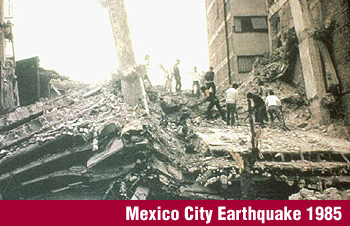 |
 |
 |
 Editorials | Environmental | August 2007 Editorials | Environmental | August 2007  
Earthquake Event Likelier than Ever?
 Joshua S. Hill - CFP Joshua S. Hill - CFP
go to original


| | The earthquake that struck Mexico City in 1985 killed thousands and caused extensive damage. Geography amplified the destruction because the city lies on landfill heaped atop the spongy sediment of an ancient lake. When the quake struck, the compressed mud of the lake bed vibrated like a giant spring beneath the city. |
In an area of the world where the specter of a massive and devastating earthquake hangs over you, the latest reports that your tectonic plates aren’t doing what they’re supposed to be doing doesn’t bode well for a wellspring of confidence. For the people of Guerrero, Mexico, this is what they are finding out, thanks to information gathered by the National Autonomous University of Mexico and CU-Boulder.

In 1985, the plate in question - the Cocos Plate – was the cause of the devastating Mexico City Earthquake. With an estimated 10,000 people dead, about 50,000 injured and a repair bill upwards of $5 billion, the 8.1 magnitude earthquake was the focus of much international attention. As Mexico City is constructed upon a water-saturated lakebed, the earthquake saw some of the most devastating effects of earth liquefaction that further added to the damage done.

GPS satellite receivers set in to action in Guerrero by the National Autonomous University of Mexico (UNAM) under the direction of UNAM geophysicist Vladimir Kostoglodov and augmented by CU-Boulder have discovered that the Cocos Plate reversed its heading in the last half of 2006 and moved at four times the normal speed.

Researchers are unsure whether this will increase the likelihood of a massive quake or decrease. CU-Boulder aerospace engineering Professor Kristine Larson says that "So far, it does not appear to be reducing the earthquake hazard."

Larson was part of a four-person team who dedicated a paper published on August 1st in Geophysical Research Letters. The other two authors were University of Tokyo's Shin'ichi Miyazaki and UNAM's Vladimir Kostoglodov and José Antonio Santiago.

The state of Guerrero was the source of the last big earthquake that devastated Mexico City, and scientists believe that the area should be expecting another earthquake in the near future. The “Guerrero Gap” is the name that scientists have given the impending earthquake, which is expected to register between 8.1 and 8.4 in magnitude.

Thanks to GPS, the ability to predict – if not stop – such events has increased dramatically. "Before GPS we thought the ground moved at a constant speed between earthquakes," Larson said. "The recognition of these transient events where the plate reverses direction is arguably the most important geophysical discovery that has stemmed from the introduction of GPS measurements." The measurements that are being conducted by Larson and Kostoglodov's research team are showing that the Guerrero slip events are the largest ever seen.

However. it is not just the Guerrero region that is being helped by these studies. Much smaller slips have occurred in the Cascadia region off the coast of Washington and Oregon, and according to Larson, the information being gathered from Guerrero could help in further understanding of these ‘subduction zones’ worldwide.

A Geek's-Geek from Melbourne, Australia, Josh is an aspiring author with dreams of publishing his epic fantasy, currently in the works, sometime in the next 5 years. A techie, nerd, sci-fi nut and bookworm, Josh can be found at JoshSHill.com for his personal blog, or at MyWritingVoice.com for his writing blog. | 
 | |
 |



